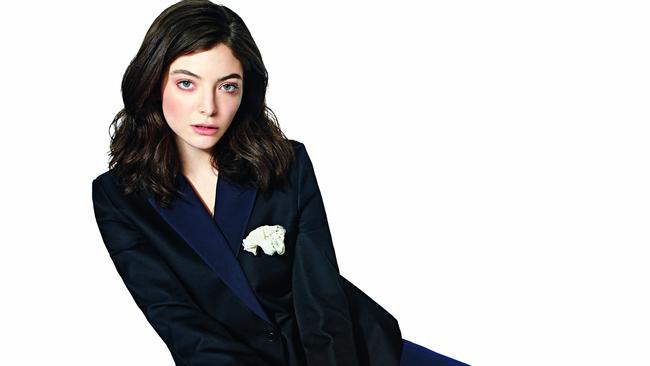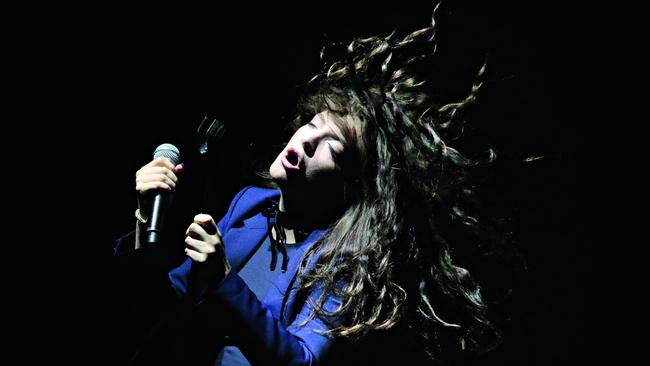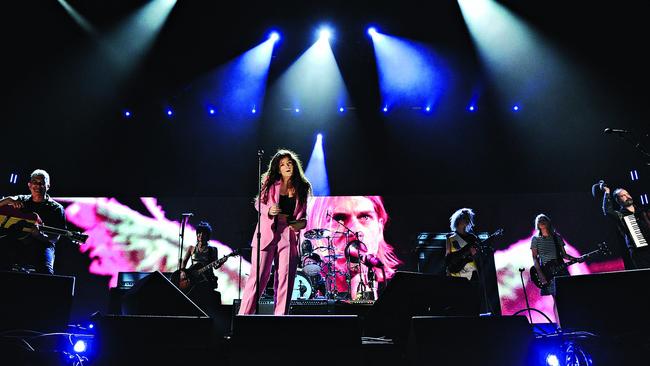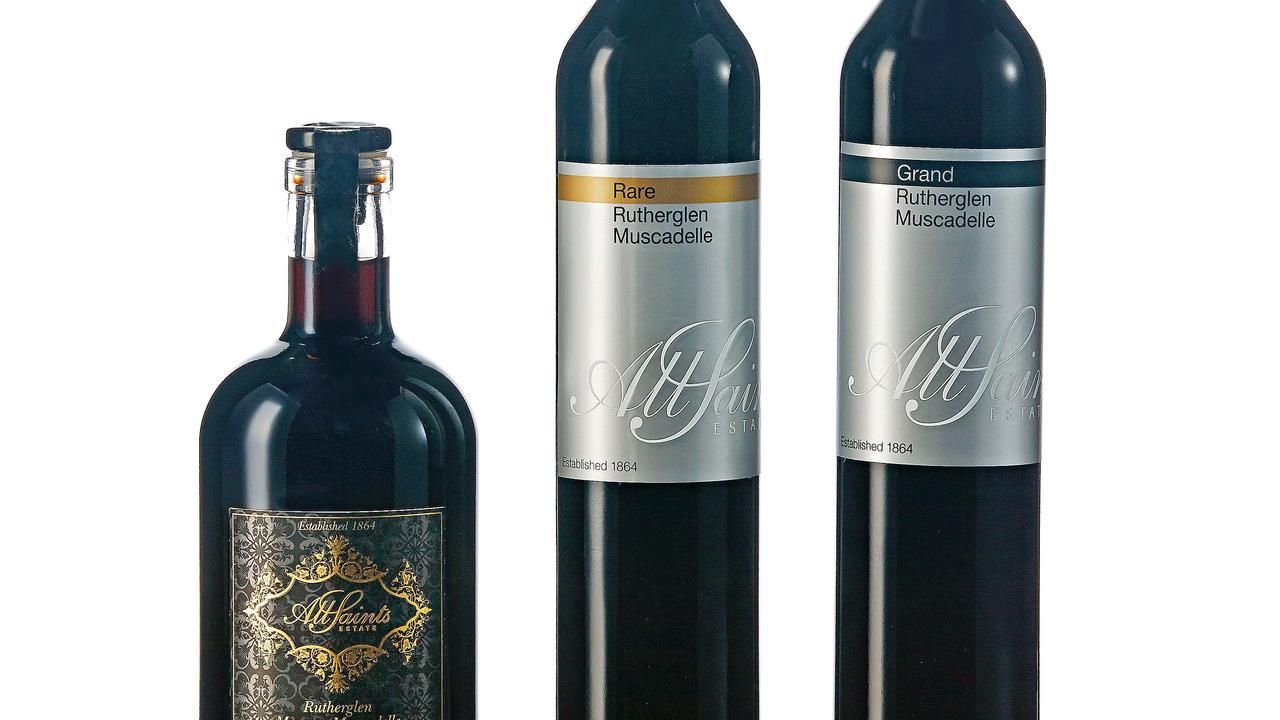This is it. It’s out of my control: second coming of Lorde
Sudden fame at 16, a creative hiatus, a breakup. Now, four years after her blockbuster debut, Lorde is back

Lorde walks into the fire-lit lounge of her downtown Manhattan hotel a few minutes past 11pm, apologising for the lateness of the hour – funny story, she says. She’s been commuting daily to a Greenwich Village recording studio, plugging away at new music, but today U2, who had reserved the space, arrived and commandeered it. Lorde found a smaller studio further uptown, and though the move was inconvenient, she saw the humour in being inadvertently evicted by Bono – it is just one more marker of how strange her life has been since she became famous, four years ago, at 16.
A late-winter blizzard is forecast to blow into town and the Kiwi pop star is dressed for the cold in pointy black boots and a voluminous Chloé overcoat. Her hair falls to the collar in waves, and the overall effect, in the light of the fireplace, is of an extremely chic witch ready for a night of haunting. She’d sent me a message earlier, hinting at some unspecified adventure. Now, boots clacking, she leads me around the corner and into an elevator, where she fishes a key from her pocket. “We’re going out a secret way,” she says, turning a lock on the wall.
Lorde owns a house in Auckland, where she grew up, but for the better part of the past year she has been living at different hotels around New York, trying to finish her second studio album, Melodrama. She began writing it about three years ago, first in her childhood home and later at a villa she bought on what she describes as the other, fancier side of Auckland’s Waitemata Harbour.
The elevator opens onto a barren nether-floor, where Lorde takes a narrow staircase down to a service exit. This hotel often hosts celebrities, she explains – “You might see Meryl Streep; you might even see a Jonas Brother” – who, in turn, draw photographers. She got this key from management so that she could come and go without worrying about cameras.
The album that made Lorde a celebrity, Pure Heroine, came out in 2013. It was a marvel of understatement – unhurried electronic beats, pared-down harmonies, empty spaces. Her lyrics brought an unlikely incandescence to avowedly mundane snapshots of suburban teendom. Itsold more than a million copies in five months, making Lorde the first female artist with a million-selling debut album since Adele and establishing her as a wunderkind pop auteur. Kanye West introduced himself as a fan; Taylor Swift became a buddy; David Bowie clasped Lorde’s hands in his and proclaimed that listening to her music “felt like listening to tomorrow”. The question nagging her here in New York, as she works to meet the new album’s June release date, is what the day after tomorrow sounds like.
We push through the service exit, walk along empty streets and board an uptown train. While making Melodrama, Lorde has taken lots of subway rides, auditioning rough mixes of songs on cheap earbuds, which helps give her a sense of how the music will sound in daily life. As we rumble northward, her face is in full fluorescent light, and I wonder if people ever bother her during these rides. “Nobody recognises me,” she says. When she does spot someone spotting her, she says, her move is to smile, place a finger to her lips and mouth a conspiratorial shhh. Her thinking is that this gesture, warm and direct in its appeal, will pre-empt any further encounter – “and it usually does”.
Part of the reason Lorde likes travelling unnoticed is that she enjoys paying close attention to strangers’ conversations. “I’ll overhear a phrase and roll it around in my mind for hours,” she says. If not a phrase, it might be a tableau that captures her thoughts. Our destination is a diner near Columbus Circle called the Flame, which sits beneath a Qi Gong parlour and whose brick façade is nondescript in the extreme. Lorde discovered the Flame by chance one night in 2013, during her first trip to the US, lured by nothing more tantalising than the neon sign reading OPEN 24 HOURS. On subsequent visits she developed a deep attachment to the place; its unchanging vinyl upholstery, grid-patterned pendant shades and Italian omelets helped to make an increasingly untethered existence feel more rooted. “Some low-key genius did the decorating,” she says. “There’s something beautiful in every corner.” Adding to the charm is that “mostly old people eat here. There’s no one famous. No one cares about me.”
The Flame played an important part in the making of Melodrama, she says: “I spent about four months here last year with my laptop out and my headphones on, listening to demos, looking at lists of what I needed to get done and writing songs. People must have thought I was an aspiring poet or something.” She sat for hours at a time, sometimes in the afternoon, sometimes in the dead of night. All the while, overhead speakers piped in Top 40 radio, which, she says, “can be distracting when you’re trying to write pop music. So I wore these enormous headphones to block it out.”
But sometimes she removed the headphones and let the songs wash over her. She has always been fascinated by pop music, relating to it in both intuitive and analytical ways since early adolescence when, she has said, she would play tracks by Justin Timberlake and Nelly Furtado on repeat, trying to figure out their magic. Her taste broadened to include more idiosyncratic sounds, and today she will talk with fervour about Katy Perry one moment, Kate Bush the next. She discusses pop in the language of a zealot and describes Melodrama as an act of zealotry. “I have such reverence for the form,” she says. “A lot of musicians think they can do pop, and the ones who don’t succeed are the ones who don’t have the reverence – who think it’s just a dumb version of other music. You need to be awe-struck.”
She brings up Teenage Dream, the smash Katy Perry single from 2010, which creates a poignant swirl of lust and nostalgia in under four minutes. “When I put that song on, I’m as moved as I am by anything by David Bowie, by Fleetwood Mac, by Neil Young. It lets you feel something you didn’t know you needed to feel.” She regards me closely. “There’s something holy about it.”

Lorde has a sly facility with pop craft that oftenexhibits itself in curveballs. She likes self-reflexive lyrics, off-kilter rhyme schemes and other irregularities just pronounced enough to draw attention to her songs’ animating mechanics without breaking their spells. Even the rhythm of her career has been unpredictable. Most A-list artists respond by working tirelessly to make sure we don’t forget them, with floods of albums, songs, cameos and headlines that will, ideally, confer upon them an aura of omnipresence, if not permanence. Some others – Adele, Frank Ocean – have made a case for scarcity, maintaining ghostlike profiles before delivering triumphant returns that feel all the more momentous for the long hiatuses that preceded them.
Lorde is staring down a four-year hiatus of her own. In the wake of her first album, she’d found much to enjoy about fame: filling in for Kurt Cobain alongside Nirvana’s surviving members at the 2014 Rock & Roll Hall of Fame induction ceremony; befriending artists such as the writer Miranda July and the Swedish pop-music mastermind Max Martin; inspiring a multi-episode South Park parody; and overseeing a Hunger Games soundtrack. But she also wondered if it was possible to return to some approximation of her previous life, so after she finished touring for Pure Heroine she pulled back from public view. Among other things, that meant hanging out with old friends in Auckland “who couldn’t care less about my music career”, she says, and a trip by helicopter to a rental house on Waiheke island, where she wrote songs without distraction.
There were false starts, fruitless detours and stretches of inactivity as she tried to plot her way forward: “I had to sort of write my way out of the last album,” she says. Things got more complicated in 2015, when she and her longtime boyfriend, Auckland-based photographer James Lowe, broke up. (Lorde declined to discuss the reasons for the split.) Amid this unhappy circumstance, another path presented itself for her songwriting. “After your heart is broken, music enters you on a new level,” she says. “You suddenly find yourself crying when Try Sleeping With a Broken Heart” – an aching Alicia Keys track – “comes on.”
She decided that the new album would grapple with emotions and insights stemming from the breakup. For the first time in her adult life, she was single. What was it like to be on a dance floor, to desire someone else on it and to act on this desire? How did it feel to wake up the next morning? She emphasises that Melodrama isn’t a “breakup album”. Instead, she says, “it’s a record about being alone. The good parts and the bad parts.”
Lorde has a neurological condition known as sound-to-colour synesthesia – when she hears certain notes and sounds, corresponding colours appear – and she describes making music in intensely visual terms. “From the moment I start something, I can see the finished song, even if it’s far-off and foggy,” she says. Her goal is to correct the colours and sharpen the contours until the precise configuration of chords, rhythms, emotions and textures she has been glimpsing all along snaps into focus. “It’s about getting the actual thing to sound like what I’ve been seeing.”
As Lorde worked on Melodrama at home in New Zealand, she papered over a wall with notes for songs, like a sleuth tacking up scraps of evidence, trying to tease out their connections and fill in their blanks. She soon devised colour codings for each song, with different hues denoting different themes. “A song about partying would get a certain colour,” she explains, “but it might be a sad song, and that got its own colour, too.” As she studied the wall, patterns and imbalances emerged: not enough red here; too much yellow there. On her kitchen table she arranged yet more paper, editing and shuffling lyrics around.
Pop music has always been a result of teamwork, but in recent years hypercollaborative approaches have become prevalent, with stars bringing legions of contributors to bear on single songs. Lorde’s process is strikingly different. She does not play an instrument, which means she must eventually enlist the help of collaborators, but she amasses them slowly and sparingly.
Pure Heroine was the work of just two writers: Lorde and a musician named Joel Little, whose most prominent job till then was as the frontman for a New Zealand pop-punk group. She initially reunited with him for Melodrama but came to believe that she needed a new conspirator to truly move beyond Pure Heroine. In early 2014 she met Jack Antonoff, who plays guitar with the band Fun and makes music on his own under the name Bleachers. They had a mutual friend in Taylor Swift, who hired Antonoff while making her last album, 1989. After a few exploratory sessions, Lorde took him on as her main co-writer.
In March 2016, she began writing a new track called Sober, whose pointed juxtaposition of pleasure (“My hips have missed your hips”) and foreboding (“What will we do when we’re sober?”) convinced her once and for all that she was onto something good. By this time, fans were demanding new music from her with mounting impatience on Twitter, Instagram and Tumblr. In no mood to rush things, she tried to tune these voices out – but it was reassuring, all the same, to know that they still cared about her.
In March this year, she finally released the first single from Melodrama, called Green Light. Two nights before our trip to the Flame, Lorde performed it on Saturday Night Live, and later at Coachella, along with a piano ballad called Liability, about how being an artist in the public eye can make you radioactive to those close to you.
Taking quite so much time on Melodrama was never Lorde’s master plan. But follow-ups are hard, especially when they follow smash debuts. For three full days before Green Light came out, she says, “I couldn’t get out of bed. I didn’t want to be out in the world. It was so intense to arrive at this moment of, ‘This is it’.” And, she added, “whatever it is, it’s about to be out of my control.”

Lorde – real name Ella Yelich-O’Connor – was born in 1996, the second of four children. Her father, Vic O’Connor, is a civil engineer; her mother, Sonja Yelich, is an award-winning poet. Ella was a bookish kid. She led her middle-school team to a second-place finish in the 2009 Kids’ Lit Quiz World Finals, a global competition. She joined student musicals and began performing acoustic Amy Winehouse and Kings of Leon covers around Auckland with a friend named Louis, who played guitar while she sang. In August 2009, Louis’s father emailed a recording of the pair performing Duffy’s Warwick Avenue to Scott Maclachlan, an executive at Universal New Zealand. Maclachlan wasn’t looking for a guitarist, but Ella’s voice intrigued him. He signed her to a development deal and worked, until a couple of years ago, as her manager.
Maclachlan finally found her a partner in Little. As things progressed, she assumed the name Lord, tacking on an “e” as a feminising flourish. She’d long been interested in “aristocracy”, she tells me, “and the Ivy Leagues and final clubs and old-money families and the concept of old money – I just find it all fascinating”.
Lorde frequently figures herself into her lyrics as a passenger, riding in a car that someone else is steering. This motif owes something to the fact that she has never learnt to drive, but it also speaks to her comfort as an observer, watching events unfold from off to one side and narrating them from a semidetached point of view. She told me that she made Pure Heroine in an “anthropological” mindset, scrutinising adolescent rituals even as she lived them firsthand. In 2014 she recalled that, while writing the album, she strove “to make sense of every weird thing that happens at a party with 15-year-olds” and, to this end, forswore alcohol, not out of “discipline as much as just wanting not to miss anything”. On the new album, that tendency towards cool detachment collapses again and again into a rush of outsize emotions. When I remind her of the teetotalling behind Pure Heroine, she laughs. With Melodrama, she says, “I went to the party and got drunk.”

A couple of days after our diner visit, Lorde invites me to a studio session. Her bugbear at the moment is a song called Perfect Places, about going to parties and hooking up, in which she pierces an atmosphere of hedonism with stabs of melancholy – a recurring technique across the album. She and Antonoff had an idea for the hook: what if a mass of multi-tracked Lordes came in, belting out the words beneath the main vocal like a choir of clones? She approaches a microphone beside the mixing board to try it out.
The hook features an emphatic confession: “Now I can’t stand to be alone.” Lorde says that for a while these eight syllables were “Now I don’t know which way to go,” but those words felt wishy-washy, and she knew they wouldn’t stick. While she argues that writing great pop lyrics tends to mean “pushing past clichés to a more specific truth”, there are nonetheless times when nothing will capture that specific truth better than the familiar phrase: “I can’t stand to be alone,” she says. “That’s why I go out.”
She moves on to an untitled ballad; it has a slow-burning section, built around piano chords, for which Lorde has yet to find a lyric or melody. “I was thinking ‘hard feelings’ could work here,” she tells Antonoff, explaining to me that “I have these phrases banging around that we try to find homes for”. She approaches the microphone again.
They listen to the playback. “See, I think -lings is hooky,” Lorde says. Antonoff nods. “This song is the moment of calm before you start raging,” she says. “I remember this being so jarring while it was happening, like: ‘Oh, this is that moment in the break- up. Until now the two of you were concentric circles, but the instant you get out of this car, you are only going to get farther apart from each other’.”
Lorde ends the session in good spirits: things are moving in the right direction. She says goodbye to Antonoff and reserves a table for dinner at the Waverly Inn. Like the Flame, this West Village restaurant is one of Lorde’s favoured New York haunts, but it’s a universe apart. The Saturday Night Live personality Colin Jost is one table over, and as we wait for our menus Lorde points across the room: “I saw [Supreme Court judge] Ruth Bader Ginsburg at that table one night.”
There can be a feeling of hypocrisy when artists who first introduced themselves as outsiders go on to enjoy success and, with it, consummately insiderish pleasures. Before we leave the studio, she debates out loud the wisdom of taking me to such a fancy restaurant, wondering how it will come off in print. “Well, I have money now,” she finally declares, “and I don’t spend it on watches or something. I spend it on food.”
I’m staying a short walk from Lorde’s hotel, so after we eat I hitch a ride in her chauffeured SUV. Every street corner is piled high with blackening snow. “I’ve never seen New York like this,” she says as we pull away from the kerb, tyres crunching. After a few blocks, Lorde takes out her phone and explains that she is eager to listen to one of the songs she’s worked on that day. Could we not talk for a bit? “Give me three minutes, I’m sorry,” she says. “I like to play things when I’m moving.”
Melodrama will be released June 16.



To join the conversation, please log in. Don't have an account? Register
Join the conversation, you are commenting as Logout